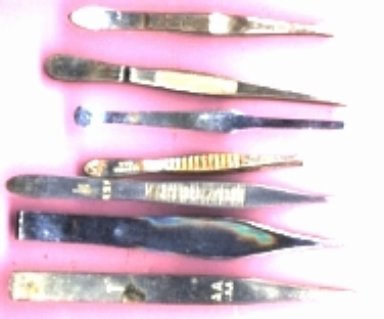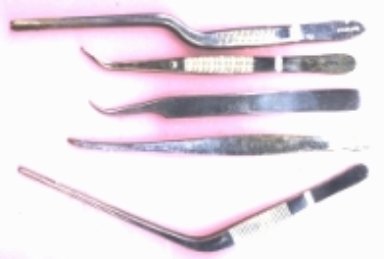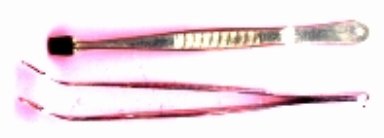>With the wide selection of tweezers available, a suitable pair may be found to manipulate almost any delicate minute object. Highly dependent on personal preference, most tips and handles allow a feel for the work. With an almost endless variety, it is often difficult to visualize the match of a pair to a use, until you need one and do not have it. Experience soon teaches the right selection and grip to avoid flying objects of the tiny kind; that disappear , never to be seen again. Some tips are serrated to reduce slippage, but they may damage delicate pieces or misalign purchase by forcing projections to follow grooves. Irregular pieces are difficult and risky to hold, unless a secure position can be located.
Among the more common types are straight legs, with varying thicknesses, widths, tapers and sharpness of points. Thinner and narrower are springier. This probably accounts for all the different tapers. Some very fine tipped types have a guide pin, fastened on one leg and a mating hole in the other, near the tips, to eliminate skewing or twisting of tips.
Straight legs are frequently used in limited access spaces or to handle tiny parts. The tip and leg shapes will be determined by the space, gripping ability and maneuvering required. If they fit, blunter tips provide better grips. Although some may provide better control, handles are mainly a matter of taste or feel. Often trial and error is the guide.

Note: Adjust brightness and contrast for optimum viewing.
STRAIGHT TWEEZERS
Shaped ends are more specialized. Slanted and broader tipped eyebrows tweezers are useful for angled work to provide visibility, like pulling splinters and of course, plucking hairs. Broader tips with rounded edges are useful for handing small thin sheets, where sharp points may puncture. Similarly diamonds permit an angled approach.

Note: Adjust brightness and contrast for optimum viewing.
STRAIGHT SHAPED TWEEZERS
Often where the straight attack is not practical, bent or curved, tips or legs may fit well; sometimes by working around obstructions. Frequently they can place parts on a surface, while providing a better grip. Smaller radius curved can be used very effectively to mount grab irons and hand rails, by providing both better grip and visibility. Curve tips make a good pry for pulling slightly, when inserted too far.

Note: Adjust brightness and contrast for optimum viewing.
BENT AND CURVED TWEEZERS
Angled perpendicular to faces with rounded edges, philatelist's or stamp collector's tweezers are ideal for handling and laying decal pieces. The angle provides good visibility and position for sliding onto surface.

Note: Adjust brightness and contrast for optimum viewing.
PHILATELIST'S BENT TWEEZERS
Too often distraction causes a relaxation of the grip on tweezers and parts drop and bounce into the hinterlands. Available in many types , locking or clamping tweezers can help eliminate the problem. They are also useful as clamps, if handle space is available. Several of the third hand stands use them with varying success. More common in hobby shops are the cross lock (sprung) in various forms. Not too good, pressure is dependent on opening gap size. Also with no pressure adjustment , another type has a latching pawl hook on one leg which engages a hole in the other, when legs are squeezed together. Locking is easy, but disengaging the pawl is difficult with only finger pressure. The remaining common types us an adjustable pressure, sliding button method, which may hinder release, due to friction. Of unique design, is a round handled, grabber with tweezer tips, pressed together by a ferrule sliding up a split conical ramp. Although much better friction still hinders easy release. With all extreme caution must be exercised to avoid flying parts, both during clamping and release. Secure positioning is a must at any stage.

Note: Adjust brightness and contrast for optimum viewing.
LOCKING TWEEZERS
cross lock curved
cross lock fine
cross lock large
cross lock offset
latch lock fine
slide lock
round handle slide lock tip (micro vise)
Of dubious use, X=acto offered a small magnifying glass mounted on a pair of tweezers. It is too often difficult to get a line of sight through the glass, during manipulation. A jeweler's eye-loupe allows more freedom. Better still for fine work; investment, in a pair of flip up, head mounted binocular magnifiers, provides a wider field of view plus depth perception and much more freedom.

Note: Adjust brightness and contrast for optimum viewing.
TWEEZERS W/ MAGNIFYING GLASS
Only through experience with the more common types in conjunction with projected needs, can good selection be ascertained for additions. Good quality is highly desirable. Visits to flea markets often reveal odd but useful types for reasonable prices.
BACK TO HOLDING
BACK TO TOOLS INDEX
